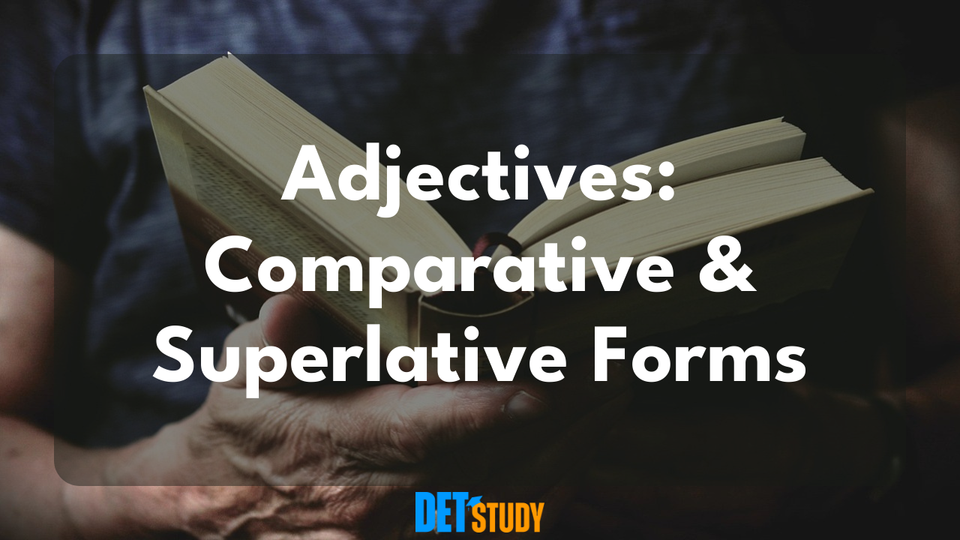Mastering Comparative & Superlative Adjectives: Elevate Your English Vocabulary with Ease

Understanding Adjectives: Basics and Importance
Adjectives describe or modify nouns, adding detail and making language more vivid. 🎨 Mastering their use, especially comparative and superlative forms, will greatly enhance your English communication.
These forms compare qualities between nouns:
5 Tips for the Read Then Speak Question: Duolingo English TestComparative Forms (Comparing Two Things)
Comparatives usually end in "-er" or use "more" before the adjective. Examples:
- Tall: Taller ("Jenny is taller than Mark.")
- Happy: Happier ("She is happier today.")
- Beautiful: More beautiful ("The garden is more beautiful in spring.")
Use "more" for adjectives with two or more syllables that don't end in "-y."
Superlative Forms (Comparing Three or More Things)
Superlatives indicate the highest degree, usually ending in "-est" or using "most" before the adjective. Examples:
- Fast: Fastest ("Usain Bolt is the fastest runner.")
- Intelligent: Most intelligent ("She is the most intelligent student.")
- Funny: Funniest ("He told the funniest joke.")
Use "most" for adjectives with two or more syllables unless they end in "-y."
Irregular Adjectives (Must Memorize) ✨
Some adjectives have unique comparative and superlative forms that don't follow standard rules. Recognizing these exceptions is crucial for precise communication:
- Good: Better, Best ("This is a better solution." "This book is the best I've read.")
- Bad: Worse, Worst ("His performance was worse." "That was the worst experience.")
- Far: Farther/Further, Farthest/Furthest ("She walked farther." "This is the farthest city." "We need further discussion.")
- Little: Less, Least ("She has less money." "This is the least expensive option.")
- Much/Many: More, Most ("More people are here." "That was the most interesting book.")
- Old: Older/Elder, Oldest/Eldest ("My sister is older." "He is the eldest member." Note: "Elder/eldest" often refer to people, especially family.)
Memorize these forms, as they are crucial for nuanced English. Context can influence "farther" (physical distance) vs. "further" (abstract concepts).
Forming Comparative and Superlative Adjectives: The Rules
Forming these adjectives depends on their structure. Here are the key rules to remember: 👇
1. One-Syllable Adjectives
Add -er for comparative and -est for superlative.
- Cold: Colder, Coldest ("Today is colder." "January was the coldest month.")
- Tall: Taller, Tallest ("She is taller." "He is the tallest person.")
If a one-syllable adjective ends in a single consonant preceded by a single vowel (CVC pattern), double the final consonant before adding -er or -est.
- Big: Bigger, Biggest ("This apple is bigger." "That is the biggest tree.")
- Hot: Hotter, Hottest ("The soup is hotter." "July is the hottest month.")
2. Adjectives Ending in -y
For two-syllable adjectives ending in -y, change the -y to -i and add -er or -est.
- Happy: Happier, Happiest ("She felt happier." "That was the happiest day.")
- Easy: Easier, Easiest ("This test is easier." "That was the easiest question.")
3. Two-Syllable and Longer Adjectives (Not Ending in -y)
Use "more" for the comparative and "most" for the superlative.
- Beautiful: More beautiful, Most beautiful ("This painting is more beautiful." "That is the most beautiful flower.")
- Difficult: More difficult, Most difficult ("This puzzle is more difficult." "This was the most difficult decision.")
Some two-syllable adjectives, like "narrow" or "clever," can use either -er/-est or more/most. For example, Narrow: Narrower/More narrow, Narrowest/Most narrow.
How to Spot Real and Fake Words on the Duolingo English Test: Best Tips for Success4. Adjectives Ending in -e
Simply add -r for comparative and -st for superlative.
- Large: Larger, Largest ("Her house is larger." "This is the largest cake.")
- Simple: Simpler, Simplest ("Instructions need to be simpler." "She provided the simplest explanation.")

Tips for Using Comparative and Superlative Adjectives in Writing ✍️
Follow these guidelines for clear and correct writing:
-
Understand the Basics: - Use comparatives for two items: "Tom is taller than Jerry." - Use superlatives for three or more: "Alice is the tallest in the class."
-
Regular Forms Recap: - One-syllable: add -er/-est (Tall: Taller, Tallest). - Ending in -y: change y to i, add -er/-est (Happy: Happier, Happiest).
-
"More" and "Most": - For most two-syllable or longer adjectives: use "more" (comparative) and "most" (superlative). (Beautiful: More beautiful, Most beautiful).
-
Avoid Redundancy: - Never use double comparatives or superlatives (e.g., "more taller" or "most tallest"). They are incorrect.🚫
-
Memorize Irregulars: - Irregular forms (Good: Better, Best; Bad: Worse, Worst) must be memorized.
-
Context & Clarity: - Ensure subjects being compared are clear. Choose comparative or superlative based on the number of items and the sentence's logical meaning.
-
Correct Comparisons: - Use comparatives for two items, not superlatives. Say "Jan is taller than Chris," not "Jan is the tallest of the two."
Applying these tips will improve your writing, allowing for more precise and vivid comparisons. ✨
DET Study offers over 15,000 practice questions to strengthen your grammar, especially with adjectives and adverbs. Prepare for the Duolingo English Test with confidence and precision to achieve your desired scores. 🚀
🎯 Need more practice? Check out DETStudy.com for expert resources, 15,000+ practice questions, and AI-powered feedback.

